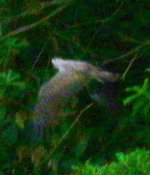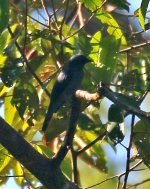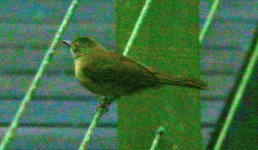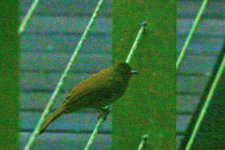Thank you very much indeed, Andy. And also JWN Andrewes and KGS, and Julien.
I managed to identify 60 species myself, but didn't expect to be able to get so much of the rest even with your expert help. It's frustrating trying to get pictures of birds in rainforest, because without much experience it's difficult to get camera settings right when a bird appears before it goes again. And if you get them right for one place or thing, then something else pops out from a different place for which the settings are not right. And of course some birds when you see them are not in a location where anyone could get a good shot (e.g. I have a series of shots of a Velvet-fronted Nuthatch climbing a dark trunk against a white sky.
(Interestingly, about half the people in the various groups we interacted with were doing all their photography on an iPhone.)
This was a first trip to Borneo (or Malaysia) and I would definitely go again. We had a super time, and the guides were really great. Of course, we were mainly there to see the orang utan and other primates, and we saw several orang utan, and everything we hoped for except Slow Loris and civets (though I got silhouette shots of a Binturong). We didn't expect the Clouded Leopard, so we weren't disappointed. We saw a large herd of Pygmy Elephants bathing and playing around by the river for about twenty minutes.
In the photos I posted here, I was particularly delighted about the Bat Hawk. We were hoping for Bat Hawk at Gomantong, but there were just Wallace's Hawk-eagle and Crested Serpent Eagle. This photo was over the river at Sukau, and I hadn't considered Bat Hawk as a possible ID.
I would love it if the poor shot was Lesser Fish Eagle, because then I would have the set (Brahminy, White-bellied, Grey-headed, Lesser). I have other shots of this bird, but the one I posted was the best one. The bird was just gliding slowly along a few metres above the river at Danum Valley at dusk, so this was the best I could do from 100m or so away. Is there anything I could look for in my other photos to decide between Grey-headed and Lesser? I attach one more shot which shows the back (kind of).
I am assuming that the crows we saw (not posted here) were all Slender-billed Crows, since this seems to be the default. If this is wrong, please let me know.
As for the swifts I posted here, they were in the centre of Kota Kinabalu at lunchtime, so I hadn't considered that they might be Edible-nest Swiftlets which I thought would be in the hills where there are caves. Maybe some people breed them commercially in the city or nearby?
We had some luck with birds and saw the Bristlehead and Pied Falconet, and I have a photo of the rear end of Storm's Stork flying away. And thanks to all your help here, I can add another twenty or so to my list.
The colours are difficult to judge from my photo, I agree, but having looked in the books I tend to go with female Asian Fairy Bluebird rather than Asian Glossy Starling. But what do I know? I attach another shot of that bird which shows the bill shape more clearly.
Thank you all again very much for your help, especially Andy.
I managed to identify 60 species myself, but didn't expect to be able to get so much of the rest even with your expert help. It's frustrating trying to get pictures of birds in rainforest, because without much experience it's difficult to get camera settings right when a bird appears before it goes again. And if you get them right for one place or thing, then something else pops out from a different place for which the settings are not right. And of course some birds when you see them are not in a location where anyone could get a good shot (e.g. I have a series of shots of a Velvet-fronted Nuthatch climbing a dark trunk against a white sky.
(Interestingly, about half the people in the various groups we interacted with were doing all their photography on an iPhone.)
This was a first trip to Borneo (or Malaysia) and I would definitely go again. We had a super time, and the guides were really great. Of course, we were mainly there to see the orang utan and other primates, and we saw several orang utan, and everything we hoped for except Slow Loris and civets (though I got silhouette shots of a Binturong). We didn't expect the Clouded Leopard, so we weren't disappointed. We saw a large herd of Pygmy Elephants bathing and playing around by the river for about twenty minutes.
In the photos I posted here, I was particularly delighted about the Bat Hawk. We were hoping for Bat Hawk at Gomantong, but there were just Wallace's Hawk-eagle and Crested Serpent Eagle. This photo was over the river at Sukau, and I hadn't considered Bat Hawk as a possible ID.
I would love it if the poor shot was Lesser Fish Eagle, because then I would have the set (Brahminy, White-bellied, Grey-headed, Lesser). I have other shots of this bird, but the one I posted was the best one. The bird was just gliding slowly along a few metres above the river at Danum Valley at dusk, so this was the best I could do from 100m or so away. Is there anything I could look for in my other photos to decide between Grey-headed and Lesser? I attach one more shot which shows the back (kind of).
I am assuming that the crows we saw (not posted here) were all Slender-billed Crows, since this seems to be the default. If this is wrong, please let me know.
As for the swifts I posted here, they were in the centre of Kota Kinabalu at lunchtime, so I hadn't considered that they might be Edible-nest Swiftlets which I thought would be in the hills where there are caves. Maybe some people breed them commercially in the city or nearby?
We had some luck with birds and saw the Bristlehead and Pied Falconet, and I have a photo of the rear end of Storm's Stork flying away. And thanks to all your help here, I can add another twenty or so to my list.
The colours are difficult to judge from my photo, I agree, but having looked in the books I tend to go with female Asian Fairy Bluebird rather than Asian Glossy Starling. But what do I know? I attach another shot of that bird which shows the bill shape more clearly.
Thank you all again very much for your help, especially Andy.










